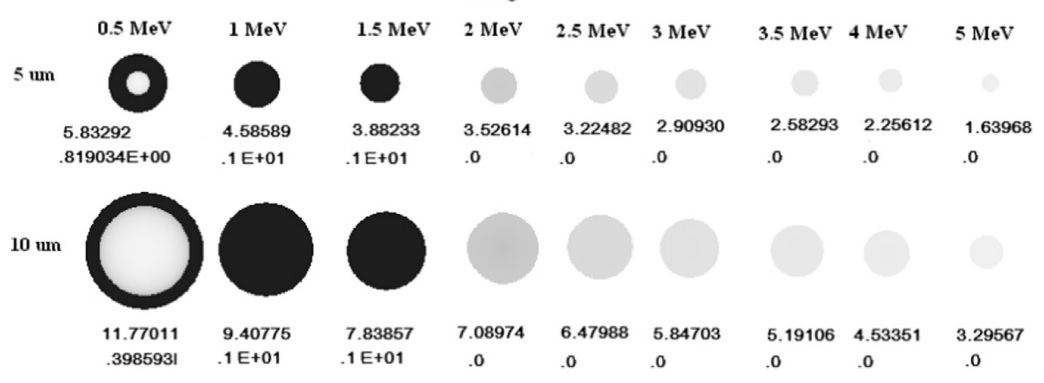|
It has been shown that detection and dosimetry of
fast neutrons are possible with solid-state nuclear track detectors
(SSNTDs). For this purpose, some converters can be placed between
the neutron source and the SSNTD to facilitate the production of
recoiled protons in the converter, which are further registered in
the SSNTD. However, under such a condition, most information on the
energy of the incident neutron will be lost. As such, it is valuable
and pertinent to explore alternative methods to be able to record
and reconstruct the energy of the incident neutrons. A theoretical
feasibility study on neutron spectrometry with the polyallyldiglycol
carbonate (PADC) solid-state nuclear track detector (SSNTD) was
carried out [1]. |
|
A computer program for studying etched proton
tracks in the PADC SSNTD was prepared [2]. The program provided
visualization of track appearance as seen under the optical
microscope in the transmission mode. Measurable track parameters
were also determined and displayed and written in a data file.
Three-dimensional representation of tracks was also enabled.
Application of this software in neutron dosimetry for energy up to
11 MeV was demonstrated through the creation of a databank with a
large number of tracks, which would be used to compare real-life
tracks obtained in the PADC detector upon neutron irradiation. One
problem was identified, viz., very similar tracks were obtained from
protons with very different energies and incident angles, and
strategies to solve this were proposed. |

Examples of proton tracks in the PADC
film detector. The tracks were generated by protons with energies
between 0.5 and 5 MeV with incident angles of 90 deg, and
corresponded to removed layers of 5 and 10
mm.
Below each image, the diameter and the fraction of black portion of
the track are shown (from top to bottom) |
|
|
|
|
|
Publications
[1]
 Nikezic,
D., Yu, K.N., 2015. Theoretical feasibility study on neutron
spectrometry with the polyallyldiglycol carbonate (PADC) solid-state nuclear
track detector. Nuclear Instruments and Methods in Physics Research A 771,
134-138. Nikezic,
D., Yu, K.N., 2015. Theoretical feasibility study on neutron
spectrometry with the polyallyldiglycol carbonate (PADC) solid-state nuclear
track detector. Nuclear Instruments and Methods in Physics Research A 771,
134-138.
[2]
 Nikezic,
D., Milenkovic, B., Yu, K.N.,
2015. Databank of proton tracks in polyallyldiglycol carbonate (PADC)
solid-state nuclear track detector for neutron energy spectrometry. Nuclear Instruments and Methods in Physics Research A
802, 97-101. Nikezic,
D., Milenkovic, B., Yu, K.N.,
2015. Databank of proton tracks in polyallyldiglycol carbonate (PADC)
solid-state nuclear track detector for neutron energy spectrometry. Nuclear Instruments and Methods in Physics Research A
802, 97-101.
|
|
Proxy
equilibrium factor (Fp)
The effective dose in the lung is mainly due to
short-lived radon progeny, i.e., 218Po, 214Pb, 214Bi
and 214Po, but not the radon (222Rn) gas itself.
Accordingly, long-term measurements of the concentrations of radon progeny
or the equilibrium factor
F, the size distribution of radon progeny and the unattached fraction fp
of the potential alpha energy concentration are needed to accurately
assess the health hazards contributed by radon progeny.
Methods for
long-term monitoring of the 222Rn gas itself are well established,
such as through the use of solid-state nuclear track detectors (SSNTDs).
|
|
Publications
-
 Nikezic,
D., Ng, F.M.F., Yu, K.N., 2004.
Theoretical basis for long-term measurements of
equilibrium factor using LR 115 detector. Applied
Radiation and Isotopes, 61, 1431-1435. Nikezic,
D., Ng, F.M.F., Yu, K.N., 2004.
Theoretical basis for long-term measurements of
equilibrium factor using LR 115 detector. Applied
Radiation and Isotopes, 61, 1431-1435.
-
 Yu,
K.N., Nikezic,
D., Ng, F.M.F., Leung, J.K.C., 2005. Long-term
Measurements of Radon Progeny Concentrations with Solid State Nuclear Track
Detectors. Radiation Measurements, 40, 560-568. Yu,
K.N., Nikezic,
D., Ng, F.M.F., Leung, J.K.C., 2005. Long-term
Measurements of Radon Progeny Concentrations with Solid State Nuclear Track
Detectors. Radiation Measurements, 40, 560-568.
-
 Leung, S.Y.Y., Nikezic, D.,
Yu, K.N., 2006.
Passive monitoring of the equilibrium factor
inside a radon exposure chamber using bare LR 115 SSNTDs.
Nuclear Instruments and Methods in Physics Research A,
564,
319-323. Leung, S.Y.Y., Nikezic, D.,
Yu, K.N., 2006.
Passive monitoring of the equilibrium factor
inside a radon exposure chamber using bare LR 115 SSNTDs.
Nuclear Instruments and Methods in Physics Research A,
564,
319-323.
-
 Ng,
F.M.F., Nikezic, D., Yu, K.N., 2007. Long-term
measurements of equilibrium factor with electrochemically etched CR-39 SSNTD.
Nuclear Instruments and Methods in Physics Research B,
263, 279-283. Ng,
F.M.F., Nikezic, D., Yu, K.N., 2007. Long-term
measurements of equilibrium factor with electrochemically etched CR-39 SSNTD.
Nuclear Instruments and Methods in Physics Research B,
263, 279-283.
-
 Yu, K.N., Leung, S.Y.Y., Nikezic, D., Leung, J.K.C., 2008. Equilibrium factor determination using SSNTDs. Radiation Measurements, 43 (Suppl. 1),
S357-S363.
Yu, K.N., Leung, S.Y.Y., Nikezic, D., Leung, J.K.C., 2008. Equilibrium factor determination using SSNTDs. Radiation Measurements, 43 (Suppl. 1),
S357-S363.
-
 Nikezic, D., Yu,
K.N., 2010.
Long-term determination of airborne concentrations of unattached and attached radon progeny using stacked LR 115 detector with multi-step
etching, Nuclear Instruments and Methods in Physics Research A, 613, 245-250. Nikezic, D., Yu,
K.N., 2010.
Long-term determination of airborne concentrations of unattached and attached radon progeny using stacked LR 115 detector with multi-step
etching, Nuclear Instruments and Methods in Physics Research A, 613, 245-250.
-
 Yu,
K.N., Nikezic, D., 2011. Long-term determination of airborne radon progeny concentrations using LR 115 solid-state nuclear track detectors.
Radiation Measurements 46, 1799-1802. Yu,
K.N., Nikezic, D., 2011. Long-term determination of airborne radon progeny concentrations using LR 115 solid-state nuclear track detectors.
Radiation Measurements 46, 1799-1802.
-
 Yu,
K.N., Nikezic,
D., 2012.
Long-term measurements of unattached radon progeny concentrations
using solid-state nuclear track detectors. Applied Radiation and Isotopes,
70, 1104-1106. Yu,
K.N., Nikezic,
D., 2012.
Long-term measurements of unattached radon progeny concentrations
using solid-state nuclear track detectors. Applied Radiation and Isotopes,
70, 1104-1106.
|
